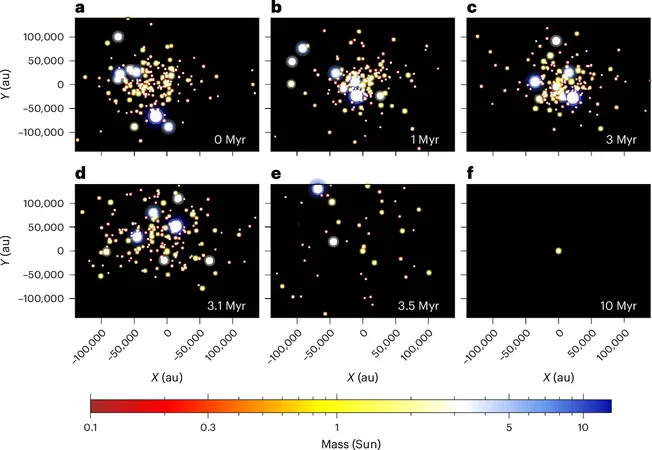
Revolutionary Study Reveals Secrets of Elusive Wide-Orbit Planets—Could Planet Nine Be Next?
2025-05-27
Author: Mei
In the far reaches of distant planetary systems, where darkness reigns and temperatures plummet, enormous gas giants drift in eerie silence—some even thousands of astronomical units (AU) away from their suns. Among them is the fabled Planet Nine, a mysterious entity that has intrigued astronomers for years. A groundbreaking new study has finally begun to unravel the enigma of how these wide-orbit planets—like Planet Nine—might form.
Published in the prestigious journal Nature Astronomy, this enlightening research from Rice University and the Planetary Science Institute offers a fresh perspective. Through intricate computer simulations, the astronomers reveal that wide-orbit planets are not freaks of nature but are birthed during the tumultuous early phases of planetary system evolution, when stars are tightly packed in chaotic clusters.
Lead author and assistant professor André Izidoro likens the process to a cosmic game of pinball, where gravitational forces send giant planets careening into distant orbits. “Inevitably, some are flung far from their original positions, but under the right conditions, these planets find themselves ensconced in stable, wide orbits,” he explains.
The research team ran countless simulations under various scenarios, examining both solar systems resembling our own and others that flaunt dual suns. They discovered a pattern: planets often find themselves in unstable, wide orbits due to internal chaos, later stabilized by the gravitational pull of nearby stars in the birth cluster.
Nathan Kaib, senior scientist and co-author, elaborates: “Once these gravitational disturbances hit at just the right moment, a planet can escape from its inner system and settle into a wide orbit, effectively freezing it in place once the star cluster disperses.”
The researchers categorize wide-orbit planets as those with semimajor axes ranging from 100 to 10,000 AU—far beyond the traditional realms of planet formation.
These findings shed light on the perplexing Planet Nine, thought to orbit our sun at distances between 250 and 1,000 AU. Although never seen directly, the unusual paths of several trans-Neptunian objects lend credence to its existence.
According to Izidoro, their simulations reveal that if the early solar system experienced two critical instability phases—marked by the development of Uranus and Neptune, followed by scattering among the gas giants—it’s quite possible, up to 40%, that a Planet Nine-like planet could have become trapped during this tumultuous period.
Interestingly, this research also connects wide-orbit planets to the growing number of rogue planets—those evicted from their systems entirely. “Not every displaced planet finds a home in a stable orbit. Most are cast adrift into the vast expanse of interstellar space. However, the rate at which some do become trapped reveals a link between those we observe in wide orbits and those wandering aimlessly through the galaxy,” Kaib noted.
The notion of "trapping efficiency"—how likely a scattered planet remains bound to its star—proves pivotal. Surprisingly, solar system-like configurations show trapping efficiencies between 5% and 10%. Others, such as those made solely of ice giants, less so.
“We predict a wide-orbit planet for every thousand stars,” Izidoro asserts. “While that may seem rare, the enormity of billions of stars in our galaxy means this could lead to significant discoveries.”
Moreover, the research points to exciting prospects for exoplanet discoveries, suggesting that wide-orbit planets are most likely found around high-metallicity stars that host gas giants. These celestial neighborhoods are prime candidates for in-depth observational campaigns.
With the Vera C. Rubin Observatory set to revolutionize sky surveys, if Planet Nine does exist, it could soon be within our sights. This advanced facility will enable astronomers to explore the depths of our solar system with unprecedented detail, increasing the chances of uncovering Planet Nine or proving it purely hypothetical.
As Izidoro puts it, “With improved insight into where to search and what to seek, we’re not only boosting the odds of discovering Planet Nine but also enhancing our understanding of planetary system dynamics across the galaxy.”




 Brasil (PT)
Brasil (PT)
 Canada (EN)
Canada (EN)
 Chile (ES)
Chile (ES)
 Česko (CS)
Česko (CS)
 대한민국 (KO)
대한민국 (KO)
 España (ES)
España (ES)
 France (FR)
France (FR)
 Hong Kong (EN)
Hong Kong (EN)
 Italia (IT)
Italia (IT)
 日本 (JA)
日本 (JA)
 Magyarország (HU)
Magyarország (HU)
 Norge (NO)
Norge (NO)
 Polska (PL)
Polska (PL)
 Schweiz (DE)
Schweiz (DE)
 Singapore (EN)
Singapore (EN)
 Sverige (SV)
Sverige (SV)
 Suomi (FI)
Suomi (FI)
 Türkiye (TR)
Türkiye (TR)
 الإمارات العربية المتحدة (AR)
الإمارات العربية المتحدة (AR)